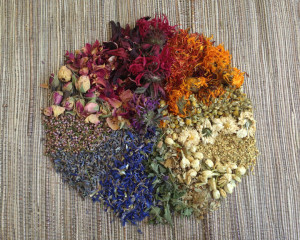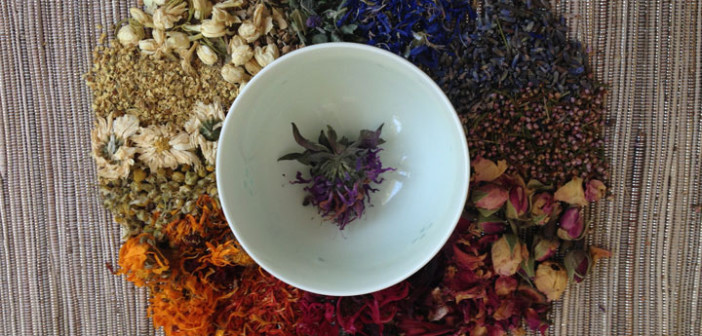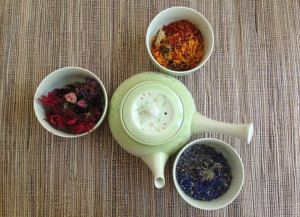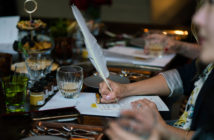In the land of tea, leaves represent the masses, but the royalty of flowers brings rich texture to loose blends and infuses a little something special into your teacup. From the simple floral focus of a lightly brewed chamomile tisane to a jasmine-kissed delicate green, you can celebrate the season by plucking garden of blooms from your tea cupboard.

Appearing (in order on “wheel” images) pink rose buds, red rose petals, hibiscus, red bee balm (& magenta bee balm), safflower, calendula, chamomile, chrysanthemum, elder, jasmine, linden, Korean licorice mint leaf & flower, cornflower, lavender, heather.
Classic Tea Flora
“Flowers have played a role in tea for thousands of years,” explains Danielle Beaudette, owner of The Cozy Tea Cart in Brookline, NH and certified tea professional.
Millennia of pairing jasmine blossoms with green tea has taken the flower’s singular identity: “Jasmine tea” traditionally means a jasmine-flavored green tea and rarely the plain jasmine flowers. Jasmine’s sweet, light, floral note tames the bitterness of true tea and enhances its relaxing properties. Another classic tisane flower, chamomile, appears solo and in a variety of herbal blends, cherished for its sedative, anti-inflammatory, and digestive properties. You’d be hard pressed to fine a more loved herbal; almost every culture reveres this tiny daisy-like flower’s slightly bitter pineapple-y flavor and ability to heal ailments for all ages, from colic in infants to insomnia in the elderly. Lastly, the flower of all flowers – the rose – appears in a wide range of traditional and herbal tea blends, lending a romantic color and flavor.
From Europe, With Love
Europeans – particularly the Germans and the French – relish an herbal tisane after meals, and these teas often feature a single or blend of mild-flavored blossoms combined with aromatic herbs. These beloved flowers found their way across the ocean to the New World, and you can easily grow, find, or buy these herbs in the United States.
The previously mentioned chamomile has earned a spot in more European cupboards than any other blossom. However, it’s not the only popular flower tea abroad. The heart-shaped leaves of the linden or lime tree create a canopy over old city streets. Walk under them in the heat of summer, and you’ll hear the happy buzz of bees glutinously working their way across the subtly beautiful green-white blossoms. Dried linden blossoms (sometimes mixed with the leaves) create a light honey-floral brew often enjoyed as a calming, after-dinner drink. It has added benefit as a heart tonic and is often added to hypertension blends as well. Elder shrubs may yield berries for a popular cold remedy; however, the creamy white flowers are prized by Europeans and herbalists as a pleasant ingredient in herbal blends for children, immune health, allergies, and respiratory infections.
Significant lore surrounds this plant, and you can imagine that a bit of its magic comes through in the tea. You can harvest your own elder flowers, but be sure that it is Sambucus nigra – other species may be toxic. Harvest the whole flower clusters, dry them thoroughly, then remove the stems by pulling the tiny flowers of with a fork (the leaves and stems of elder can be toxic, but the dry flowers are very safe). Both elder and linden flowers make lovely cordials infused in brandy and sweetened with honey or simple syrup and perhaps a little lemon zest. The classic French liquor St. Germain is made with elder flower and tastes delicious drizzled into champagne as a light spring-summer cocktail.
Backyard Blossoms
The flowers that associate themselves with tea need not travel from the far-flung reaches of the world. Many can be grown right in your backyard, growing in a riot of wild color, ripe for your picking. Wild red clover and dandelions flowers can both be plucked and enjoyed. Pinch off the tops of the red clover – leaves and all – but you may want to separate the yellow petals from the green leaves and sepals of dandelion to avoid the herb’s famous bitter properties. Both red clover and dandelion are rich with nutrition and have some gentle detoxifying properties. In the garden, enjoy the multitude of vibrant blossoms available from various bee balm species and varieties, which taste like a cross between oregano, thyme, and honey. Add the flowers to homemade blends for a beautiful appearance and sweet-spicy aromatic note – the leaves offer similar but stronger flavor and a hint of acridity. Calendula blossoms, available in varying shades of yellow and orange with tinges of red, contain 100 more carotenoids than sweet potato by weight and are classically added to soup broths to add a golden hue. Though calendula can be bitter in excess, a few petals speckled into a tea blend will add color and nutrition without affecting the flavor. I also urge you to plant an Agastache species for its tasty leaves and gorgeous purple flower spikes. Anise hyssop and Korean licorice mint are nearly identical, but I think it’s worth seeking out the harder-to-find Korean licorice mint because of its excellent fennel-honey flavor. It grows easily from seed, and this short-lived perennial will self-seed happily for a continuous supply of tea year to year. Add just a pinch of unopened lavender buds to blends for craft-shop appeal and relaxing, anti-inflammatory properties.
Color Therapy
Sometimes, we add flowers to tea blends just for their pretty faces. “If you’re using it aesthetically, it helps to sell the tea,” explains Beaudette. Even if the flowers don’t lend flavor, adding them to a flavored tea makes it more enticing and appealing.
Many different species of mallow can be used, and the pink blossoms often turn a soft blue-ish purple once dried. Meanwhile, the vibrant blue cornflower petals perk up any blend. Safflower, though strong in flavor, melds nicely in robust blends and tints both the dry blend and the brewed tea reddish orange.
Hibiscus may be the most famous color therapy tea ingredient – its vivid red calyx imparts a cranberry-like tart flavor and vivid hue to the brewed tea. Look closely at almost any fruit-flavored blend, and you’ll find hibiscus flowers on the ingredient list. Recent research supports its use as a nutrient- and antioxidant-rich heart tonic, thanks to those red-purple pigments.
Asian Fusion
Some of our more exotic tea blossoms crossed the same travel routes as true tea with ties to Traditional Chinese Medicine. Happy chrysanthemum flowers, sweet honeysuckle blooms, rich safflower petals, and the sweetly aromatic pink puffs of mimosa are as apt to find their way into beverage teas as medicinal blends.
No matter what kind of blend you’re creating, consider adding a pinch or two of flowers. Flowers represent the plant world’s highest aspirations and brings an extra sense of life, joy, and sensuality to your cup of tea.
| Color (Dry) | Name | Latin Name | Flavor | Healing Properties |
| Red-Magenta-Purple | Bee Balm | Monarda, various species | Spicy, Oregano/Thyme, Sweet | Warming Immune & Respiratory Tonic, Digestive |
| Red** | Hibiscus (Roselle) | Hibiscus sabdariffa | Fruity Tart-Sour | Antioxidant, Heart Tonic |
| Red-Orange* | Safflower (Hong Hua) | Carthamus tinctorius | Strong but Pleasant | Heart Tonic & Blood Mover |
| Orange-Yellow* | Calendula | Calendula officinalis | Bitter, Vitamin-y (mild) | Healing, Nutritious, Gently Detoxifying |
| Yellow | Dandelion | Taraxacum officinale | Sweet (mild) | Nutritious, Gently Detoxifying |
| Yellow & White | Chamomile | Matricaria recutita | Pineapple-Bitter (strong if over-brewed) | Calming, Digestive, Healing |
| Yellow & White | Chrysanthemum | Chrysanthemum morifolium | Bitter (mild) | Immune Tonic |
| Tan-White | Elder Flower | Sambucus nigra | Floral-Honey (mild) | Immune & Respiratory Tonic |
| Greenish White-Tan | Honeysuckle | Lonicera japonica | Floral-Sweet (mild) | Immune & Respiratory Tonic |
| Greenish White | Jasmine | Jasminum odoratissimum, J. officinale | Floral (mild) | Calming |
| Greenish White | Linden (Lime Tree) | Tilia, various species | Floral-Honey | Calming, Heart Tonic |
| Blue | Cornflower | Centaurea cyanus | Mild | Generally used for color |
| Blue-Purple | Mallow & Hollyhock | Malva and Althea, various species | Mild (slightly slimy texture) | Healing, Soothing, Gut Tonic |
| Purple | Anise Hyssop & Korean Licorice Mint | Agastache rugosa, A. foeniculum | Sweet Licorice-Honey | Antioxidant, Digestive |
| Purple | Lavender | Lavandula angustifolia | Aromatic, Bitter (strong) | Healing, Antimicrobial, Digestive, Calming |
| Mauve-Purple | Heather | Calluna vulgaris | Aromatic, Floral | Less often used |
| Purple-Red | Red Clover | Trifolium pratense | Sweet Hay | Reproductive Tonic, Gently Detoxifying |
| Pink | Mimosa | Albizia julibrissin | Sweet (mild) | Mood Lifting, Calming |
| Red-Pink | Roses | Rosa, various species | Floral, Bitter, Astringent (mild) | Healing, Gut & Reproductive Tonic |
* Imparts color on final brew
note that this was previously posted in June 2014





